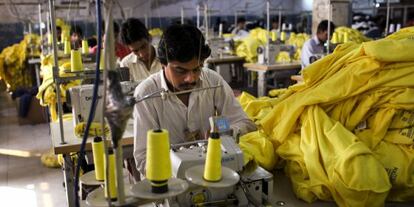Bringing it all home
As manufacturers abandon their production centers abroad, "made in Spain" is back in fashion

The reputation of Spanish fashion brands is growing by the day, as is their market share, but the same does not go for the domestic clothing and textile manufacturing industry, where hundreds of factories have closed their doors. In the 1990s, some 300,000 people worked in the clothing manufacturing sector in Spain, but now scarcely more than 135,000 do as a result of companies relocating their output to Asian countries, above all China. However, just as the trend seemed inexorable, there have been signs of change of late. After two decades of a delocalization boom, there are now growing calls to bring part of the production that has moved overseas back home to Spain - and it is already taking place. According to Ángel Asensio, the president of the Spanish Federation of Clothing Companies (Fedecom), 15 percent of delocalized production has been returned to factories in Spain and Portugal.
An increasing number of companies has announced the transfer of their production centers back to Spain. These include small firms such as Lenita, which specializes in swimwear, bag manufacturers Dándara and Vega Cárcer and footwear maker Rebeca Sanver, as well as giants of the industry such as LVMH, which in 2010 decided to open a factory in Spain to make belts for the rest of the world. Another leading fashion retailer to have opted to relocate part of its output back home is Inditex, which increased the orders it placed domestically to 3.4 billion euros last year from 2 billion in 2011.
This phenomenon is not unique to Spain. In the United States, where 97 percent of the clothing worn in the country is manufactured overseas, some fashion brands, such as Karen Kane, Abercrombie, Levi's, American Giant and Brooks Brothers, have started bringing production back home. According to a study by The Boston Consulting Group (BCG), 48 percent of US firms with annual turnover of more than $10 billion have unveiled plans to relocate part of their production back to the United States. There is a similar trend in Europe.
In 2012 Inditex upped domestic orders to 3.4 billion euros from 2 billion in 2011
The reason behind this is that China is no longer such an attractive manufacturing platform for exports. Sharp rises in wages alongside the appreciation of the yuan on top of transport costs and import tariffs have wiped out the advantages China enjoyed years back. According to BCG, industrial wages in China climbed annually by 19 percent between 2005 and 2010, while they fell 2.2 percent in the United States. According to Fedecom's Asensio, "within only a decade salaries in the textile sector in China have moved from $150 a month to more than $400."
The labor market has also become more demanding in other ways with an increase in strikes and tighter legislation - in contrast to the trend of deregulation of wages and working conditions in Europe and the United States. That does not mean that Western brands plan to abandon China, which has a domestic market of 1.5 billion people, but rather that it has now become more competitive to manufacture in Europe and the United States.
But costs do not explain everything. Many companies do not produce enough to make it viable for them to place the large bulk orders required in China, while others lack the credit required to subcontract overseas or mention quality problems. "We have decided to bring production back here because the finishing is better and quality control is easier," sources at Vega Cárcer explain.
China is no longer such an attractive manufacturing platform for exports
The so-called ready fashion model has also taken root, which requires clothing companies to have their sources of production much closer to their markets in order to replenish stocks with greater frequency. "You can't spend months waiting for orders from China," Fedecom's Asensio says.
The question of a company's image also comes into question when deciding where to locate production. The relocation of output to low-wage countries has come under greater scrutiny and criticism in the wake of tragedies such as the recent collapse of a building housing clothing manufacturing facilities in Bangladesh.
There is also a growing trend of buying locally produced products. A study by ARG shows that 75 percent of US consumers would be prepared to pay more for products made in the United States. There is growing pressure on large Western companies to stop destroying employment in industry and bring production back home. The United States and Britain have already put initiatives in place to achieve the return of clothing manufacturing, with the British government presenting a plan to create 200,000 jobs. Some cities in the United States have also taken up the issue with campaigns such as Manufacture in New York. In Spain, the ruling center-right nationalist CiU group in Catalonia has suggested to the central government that it should increase tax incentives for companies that want to relocate output back home. Many employer groups have also come out in favor of this. In Valencia AEPRI, which groups together manufacturers of children's wear, is promoting a multi-company center to carry out the first phases entailed in manufacturing clothing, with six firms signing up for the initiative.
We have brought production back because quality control is easier"
Despite the change in trend there are still doubts. The big challenge in Spain is to rebuild an industrial sector that to a large extent has disappeared as a result of delocalization. Fedecom's Asensio says that in order for this to be possible "you will have to carry out a reorganization that responds to the new demands of production." This will entail massive investment in the latest generation of equipment and in training workers in new techniques, something very difficult in the current restrictions on credit. According to a 2012 study by Cluster Development, what are also required are collaboration agreements between companies, an improvement in the design capabilities of suppliers and integrated management services for production.
Such change is likely to take longer in the clothing industry, which continues to see factories close and jobs lost, than the footwear sector, which is managing to create employment, with the nationwide workforce swelling from 22,800 to 24,300 over the past two years. The extent of the loss of industrial capacity of the clothing industry has been such that companies looking to manufacturer closer to home have been obliged to do so in Portugal or Morocco. To stem this tide, industry sources say what is required is for large chains such as Mango, Inditex and Cortefiel, which still rely on offshore facilities for 90 percent of their production, to opt for a more home-based solution for their manufacturing needs.
Tu suscripción se está usando en otro dispositivo
¿Quieres añadir otro usuario a tu suscripción?
Si continúas leyendo en este dispositivo, no se podrá leer en el otro.
FlechaTu suscripción se está usando en otro dispositivo y solo puedes acceder a EL PAÍS desde un dispositivo a la vez.
Si quieres compartir tu cuenta, cambia tu suscripción a la modalidad Premium, así podrás añadir otro usuario. Cada uno accederá con su propia cuenta de email, lo que os permitirá personalizar vuestra experiencia en EL PAÍS.
En el caso de no saber quién está usando tu cuenta, te recomendamos cambiar tu contraseña aquí.
Si decides continuar compartiendo tu cuenta, este mensaje se mostrará en tu dispositivo y en el de la otra persona que está usando tu cuenta de forma indefinida, afectando a tu experiencia de lectura. Puedes consultar aquí los términos y condiciones de la suscripción digital.







































